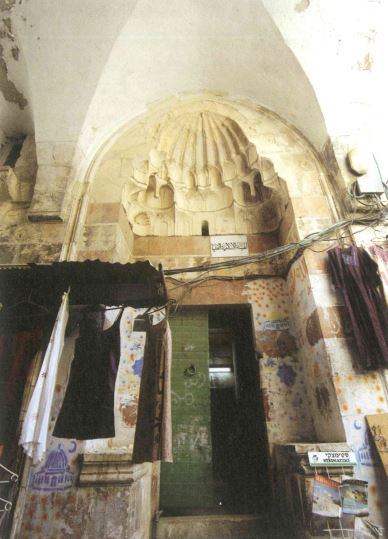Al-tashtamariya school
It is located before the road leading to Bab al-Silsila on the turn of Abu Madin road.
The school consists of four parts, namely: the Madrasa, the mausoleum, a water fountain and classrooms for orphans, the school has an exquisite Mamluk style, where its northern facade overlooks the Bab al-Silsila road, and above this facade is an alabaster stone inscribed in Mamluk copies and in large letters "order to establish this blessed place the honorable residence of Al-Saifi tashtamar Al-Alai dated the year Eighty-Four and seven hundred ah", and corresponds to 1382 ad.
The imam's family acquired ownership of the building and stopped using the family (atomic Waqf), and the ground floor is currently used as the headquarters of the Council of the Supreme Islamic Commission and five families live on the upper floors.
Recently, all the parts of the building used by the council and the residents were restored and the service networks were rehabilitated.the project was completed in 2004, where Prince Saif al-Din al-tashtamri and his son Ibrahim were buried.
The reason for the name of the school is called tashtamriya, after it was built by Prince Saif al-Din al-tashtamri, and it was built in the Mamluk era specifically in 1397, and is located before the road leading to Bab al-Silsila on the turn of Abu Madin road, and consists of four parts, (school, mausoleum, water fountain, classrooms for orphans), and this school has an exquisite Mamluk style, where its northern facade overlooks Bab al-Silsila road and above this facade is an alabaster stone inscribed in Mamluk copies and in capital letters the following words: "order to establish this place blessed is the honorable residence of Al-Saifi tashtamar Al-Alai dated Eighty-Four and seven hundred years," and corresponds to 1382 ad.
The imam's family acquired ownership of the building and stopped using the family (atomic endowment). the ground floor is currently used as the headquarters of the Council of the Supreme Islamic authority and five families live on the upper floors. all parts of the building used by the council and the residents were restored and the service networks were rehabilitated. the project work was completed in 2004. prince Saif al-Din al-tashtamri and his son Ibrahim were buried there.

